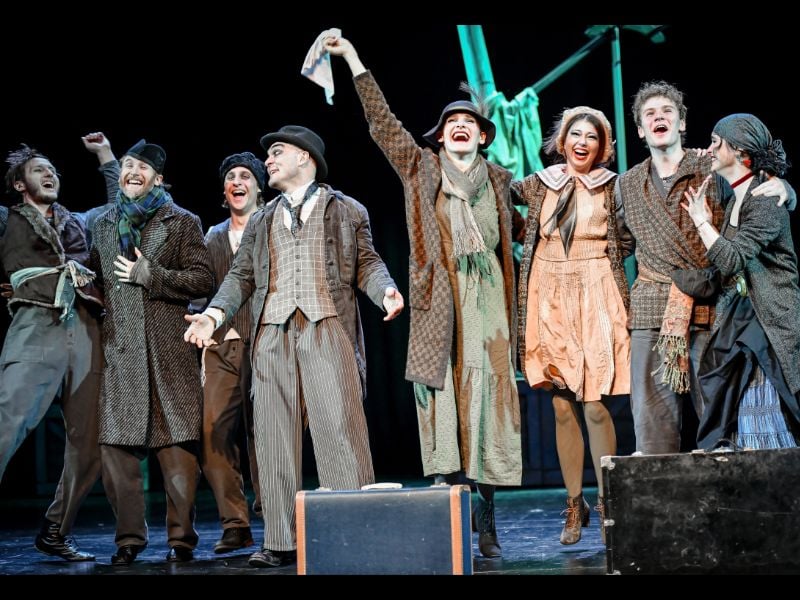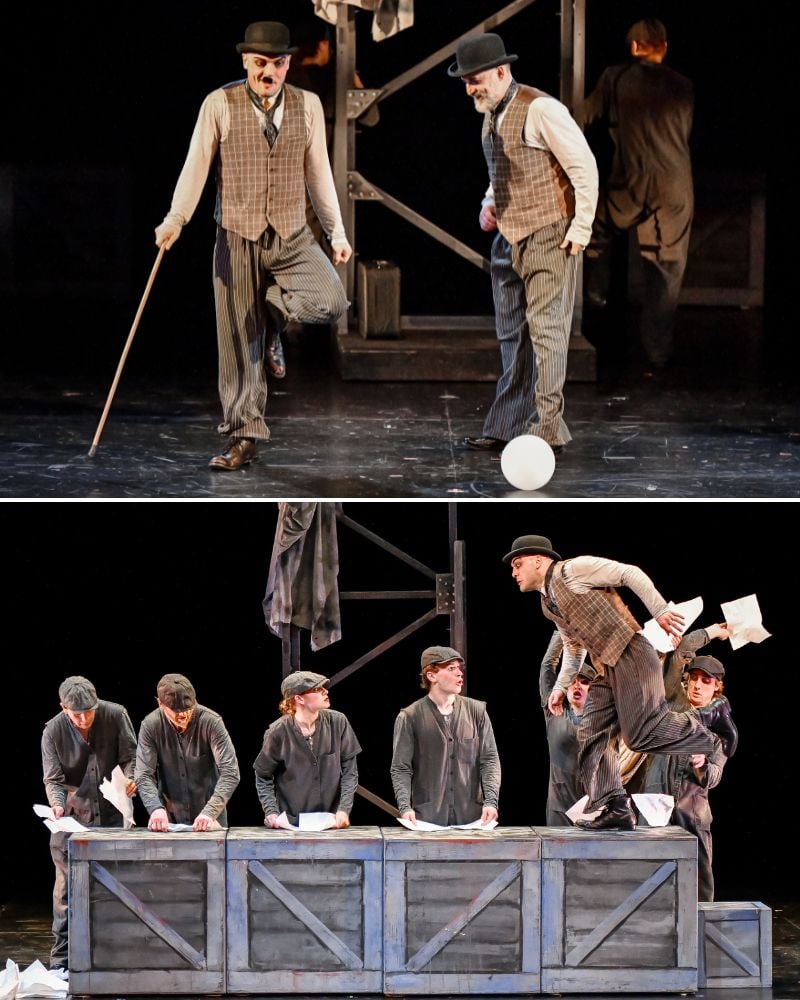The DMV has been fortunate to have the one-of-a-kind movement-theater company Synetic Theater in its midst for nearly a quarter of a century. Founded by Georgian émigrés Paata and Irina Tsikurishvili in 2001, the then-young troupe of creatives drew from their Georgian and Russian-style training in dance, mime, theater, and film to forge their new American theatrical identity. And they did it by eschewing spoken language with Hamlet … the rest is silence, by taking the poetry of Shakespeare’s drama out of the equation and distilling the tragic tale of star-crossed lovers into movement. Their inventive offerings over the decades have enhanced the theatrical landscape of the region.
After 14 wordless Shakespeare adaptations, and dozens and dozens of other adaptations from the theatrical canon, Synetic selected the perfect vehicle for this moment and its expertise at wordless theater: Charlie Chaplin’s 1917 romantic comedy The Immigrant. Created during the early years of commercial film, when movies were silent, The Immigrant tells the wordless story of Chaplin as a young, hapless yet clever émigré. Viewers follow his escapades aboard a ship sailing to New York, glimpsing the Statue of Liberty, passing through Ellis Island, and making his way into the modern, bustling city.

Synetic’s co-founders Paata and Irina Tsikurishvili co-directed the production, and founding company member Nathan Weinberger adapted this iconic piece of film and American history for the stage. Featuring Koki Lortkipanidze’s remixing and original compositions and sound, joined with additional music by Aaron Kan, the classic piano of silent film accompaniment dominates, enhanced with environmental sounds of water, rain, and other atmospheric and jazzy music, while playing an equal partner in the storytelling. Phil Charlwood’s set feels spare on the wide Thomas Jefferson Community Theatre Stage, yet the minimal boxes and roughhewn structures elegantly and simply morph into the ship deck, a dining hall at sea, the iconic torch and crown of the Statue of Liberty, a factory, a restaurant, and a filmmaker’s studio.
This adaptation maintains the episodic structure of the Chaplin film but bookends it with a prologue and epilogue of sorts. In these scenes, we see an elder filmmaker — Chaplin as immigrant at the end of his career — editing and marking up strips of film. Paata Tsikurishvili, sporting a graying beard, plays the aging immigrant Chaplin with pathos and dignity. He has a world-weary demeanor that speaks volumes of his hard-won success both as the character he portrays and in his personal story of reinvention in a new country, a new language, and a new culture over the past quarter century.
As the classic Chaplin character, here known as Little Fellow, the Tsikurishvili son, Vato, proves masterful, channeling his agile mimetic gestures and iconic duck-footed walk with that graceful sway. Clad in Chaplin’s signature baggy pants and black bowler hat, Vato allows for Chaplin’s naïve, childlike wonderment and his nimbleness to shine forth in this boy-meets-girl-and-falls-in-love story. In the midst of this gentle encounter with Hetty (innocent Maryam Najafzada), that all starts with a glimpse and an accidental brush of hands, a sweet romance blossoms.

The dinner scene on the rocking ship is among the most memorable from the original film. As the camera swayed back and forth to create the rocking deck, plates slide back and forth across the table while Chaplin tries to get a quick spoon of soup before it slides away. On stage, the camera-rocking effect has been replaced with rocking chairs, and chuckles follow.
During this sea adventure, the Little Fellow faces little challenges. He finesses a high-stakes shell game. Then, when Hetty and her sister are pickpocketed, the Little Fellow tries to replace the stolen cash, only to be accused of stealing. But throughout his journey, he’s scrappy and inventive enough to find a way out. These include a restaurant scene with Hetty when he’s short of cash, meeting an artist, working at a mechanized factory, and a fateful encounter with a film producer.
The Little Fellow becomes a filmmaker and in one of the most intriguing moments pays homage to another Chaplin classic: The Great Dictator. He dons a toothbrush mustache, which immediately recalls Adolph Hitler, mounts the wood scaffolding, and embraces an oversized globe. Chaplin’s bold message against war and world domination was clear in 1940, as is Little Fellow’s today in 2025, when fascism seems to be in fashion again.
Throughout, the 10 artists on stage form a tight ensemble, stylishly dressed in Erik Teague’s period costumes: ankle-length dresses and sleek flapper outfits for the women and two-button suits or work uniforms and shirts for the men. Irina Tsikurishvili’s choreography is typically a treat, and here is no exception. The chaotic rush of dancing people in the streets of turn-of-the-20th-century New York pays homage to beloved, energetic Busby Berkely numbers. Aboard the ship, passengers tumble and roll and Vato shows off his acrobatic skills in the off-kilter dining-on-the-ship scene. She also includes a swing dance sequence and nods to currency with a few performers finessing the snaky arm wave from one hand through elbows and shoulders and out the other arm, now seen in hip-hop dance.
In the hands of Synetic’s incredibly inventive artists, The Immigrant is far more than a remake of the indelible silent film. The 90-minute production — on stage at Thomas Jefferson Community Theatre in Arlington through March 23 before it moves to Theater J in the District on April 11 — is, like each of Synetic’s wordless Shakespeare adaptations, a perfect vehicle for Vato and Paata to share the stage. The lovely manner in which both men pay homage to the fount of creativity of early film innovators who invented a new art form that has in essential ways changed the world is touching because the Tsikurishvilis have given so much of their own inventiveness to the theater community in the DC region.
For those who have followed the Tsikurishvilis from their pre-Synetic days creating a children’s theater company, how wonderful to see Paata and Vato — father and son — share the singular role of The Immigrant/Little Fellow. They embody Chaplin’s Immigrant — his innocence and his wonder’ his quicksilver walks and his gravitas, along with his striving and indomitable spirit of reinvention. The two characters become reflections of past and future, in a way that film itself has served as both an aide memoire and a divination. Thus, while 1917’s The Immigrant allows us to glimpse a moment in time past, Synetic’s The Immigrant not only looks back at where we were but remains a living, breathing vehicle that addresses the present political moment when worrying and denigrating discourse on immigrants and immigration abounds. Of course, Americans love to define themselves/ourselves as a nation built by immigrants. Yet, turn the page in the history books or open up a newspaper to read of the continuing long-held animosities about welcoming newcomers to the United States. Synetic reminds its audiences that we all have immigrant stories, immigrant histories, immigrant families, friends, neighbors, and colleagues in our midst. We must not forget where we came from and where we’re going. The Immigrant is an evocative reminder.
Running Time: 90 minutes with no intermission.
The Immigrant plays through March 23, 2025, presented by Synetic Theater performing in the Thomas Jefferson Community Theatre, 125 S Old Glebe Rd, Arlington, VA. Tickets ($35–$65) are available online, at the theater box office (open an hour before showtime), by email at boxoffice@synetictheater.org, or by phone at (703) 824-8060 x117. The Immigrant also plays April 11 to 27, 2025, at Theater J (the Aaron & Cecile Goldman Theater in the Edlavitch DC Jewish Community Center), 1529 16th St NW, Washington, DC. Tickets ($59.99–$79.99) are available online or by phone at (202) 777-3210.
The playbill for The Immigrant is online here.
The Immigrant
CAST
The Immigrant: Paata Tsikurishvili
Little Fellow: Vato Tsikurishvili
Hetty: Maryam Najafzada
Hetty’s Sister: Stella Bunch
The Producer: Philip Fletcher
Ensemble/Understudy Little Fellow: Natan-Maël Gray
Ensemble: Lev Belolipetski
Ensemble: Nutsa Tediashvili
Ensemble: Chris Galindo
Ensemble: Joshua Cole Lucas
Understudy Hetty’s Sister/Ensemble: Camille Pivetta
Understudy The Producer/Ensemble: Rodin Alcerro
Understudy Ensemble: Kaitlyn Shifflett
CREATIVE TEAM
Co-Director & Adaptation: Paata Tsikurishvili
Co-Director & Choreographer: Irina Tsikurishvili
Adaptation: Nathan Weinberger
Lighting Designer: Brian Allard
Costume Designer: Erik Teague
Set Designer: Phil Charlwood
Technical Director: Joshua Cole Lucas
Production Manager: Amy Kellett
Production Stage Manager: Khue Duong
Sound Designer, Composer & Remix: Konstantine Lortkipanidze
Assistant Director & Co-Sound Designer: Irakli Kavsadze
Additional music: Aaron Kan
Audio Engineer: Levi Manners
Assistant Stage Manager: Natasha Sanchez
Assistant Lighting Designer: Dean Leong
Assistant Costume Designer: Channing Tucker
Additional Music: Aaron Kan
Lighting Supervisor: Alex Keen
Lighting Programmer & Board Op: Susannah Cai
Draper: Kristin Patrick
Scenic Artist: Tim Grant
Carpenters: Pete Neil, Tony Ritchie
Creative Team: Vato Tsikurishvili, Maryam Najafzada, Stella Bunch, Natan-Maël Gray, Lev Belolipetski, Katie Buchwell
Stage Manager Cover: Katie Buchwell



